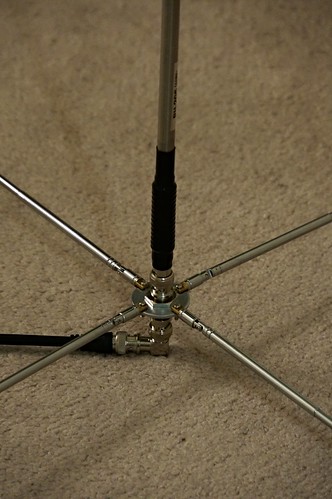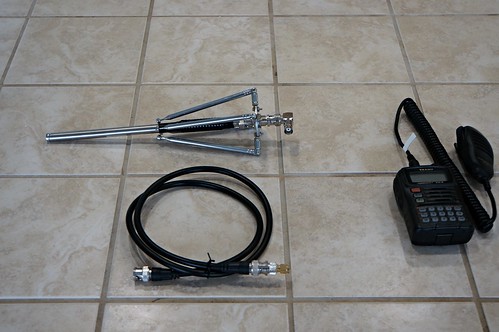For the vertical antenna, I used a Diamond RH205 base-loaded telescoping 2-meter whip. For the ground plane, I used four 19.3-inch 6-section whips (hinged at the base, with a 2.5 mm hole at the mounting end).
Construction centers on a steel washer; I used one with a diameter of about 1-1/2 inches (4 cm). I drilled four equally-spaced 2.5-mm holes around its circumference. The washer was then mounted on an Amphenol BNC female-to-female connector with a threaded body for panel mounting. I tightened the washer in place with the lock washer and nut that came with the connector. I mounted one of the smaller whips to each of the 2.5-mm holes, using machine screws, lock washers and nuts.
A 3-foot length of coax cable with male BNC connectors at each end connects the bottom of the Amphenol connector to the radio (in my case, a female BNC to male SMA adapter is needed to connect to my Yaesu VX-6R).
The only liberty I took with the original plan was to add a 90-degree BNC female-to-male adapter to the bottom connector; the original plan has the coax plugging straight up into the bottom connector. I'm not yet sure if this change will affect the efficiency of the antenna. I hope to acquire an SWR meter soon.
As I said before, this is a great first project for a new ham. There is no soldering or welding involved; the most difficult part (and not too badly so) was drilling the four holes in the steel washer.
With all whips fully extended, the antenna stands 54 inches (137.16 cm) tall and 40 inches (101.6 cm) wide. It folds and telescopes down to a small package of 10 by 3 inches (25.4 x 7.6 cm).
With all whips fully extended, the antenna stands 54 inches (137.16 cm) tall and 40 inches (101.6 cm) wide. It folds and telescopes down to a small package of 10 by 3 inches (25.4 x 7.6 cm).
In my next post, I'll discuss my first test of the new antenna. Below are a few photos of the finished product.



No comments:
Post a Comment